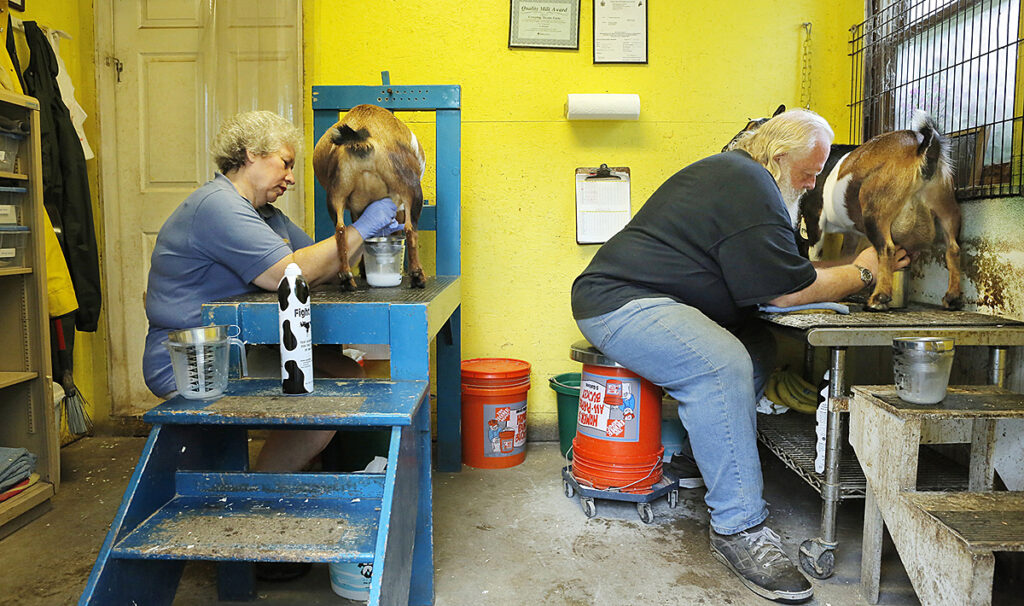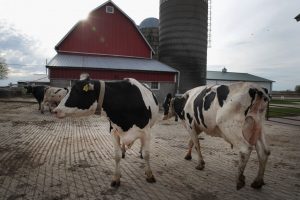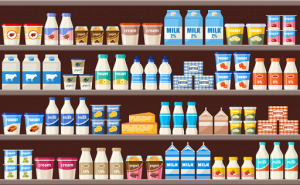
The most popular milk worldwide comes out of goats. The U.S., where cow is queen, is an outlier. But new data shows that even in America, dairy goats are having a moment.
Dairy goats herds expanded faster than any other major livestock group in the U.S. over the past decade. They’ve grown 61 percent between 2007 and 2017, according to the USDA’s latest Census of Agriculture, a once-every-five-years inventory of the nation’s farms. For context, broiler hens and beef cattle were relatively flat and numbers for specialty animals such as llamas, ostriches and emus fell off a cliff.
The surge comes as goats have permeated pop culture. We’ve seen them frolicking and doing parkour while sporting adorable onesies on YouTube. We’ve maybe hoisted a 20-pound Nubian aloft in everybody’s favorite novelty yoga practice. And rent-a-goats are running amok in Boise and helping clear brush and prevent wildfires in California.
Dairy-goat herds grew in all 48 states for which we have data. But the greatest increases came in the nation’s three biggest goat-dairy states: Wisconsin (up 47,000), Iowa (up 18,000) and Texas (up 20,000).
Wisconsin’s growth came even as the number of goat dairies in the state shrank and the number of goats per dairy soared, a sign of increasing consolidation in the industry.
According to Janet Fletcher, publisher of the Planet Cheese blog and author of three books on cheese, small-time goat-milkers are being bought out by those with enough cash to compete on a global scale. She points to the 2017 sale of Meyenberg Goat Milk Products of Turlock, California, and the 2015 sale of Redwood Hill Farm in Sebastopol, California. Both were scooped up by Swiss dairy giant Emmi, which also bought Cypress Grove Chèvre, makers of the cult cheese Humboldt Fog.
And at the end of 2017, Canadian dairy giant Saputo bought Wisconsin-based Montchevre for $265 million. It’s now one of the largest goat cheese producers in North America.
Dairy goats’ gain may be dairy cows’ loss. The nation’s dairy herd grew just 3 percent from 2007 to 2017, with growth so concentrated in Texas, Michigan and Idaho that about three out of every five states actually ended the period with fewer cows.
Studies show more than 3 percent of children have a cow’s milk allergy. It can cause gut symptoms and skin problems such as eczema. But allergies alone don’t explain the decline of cow’s milk. According to the USDA, an average American drinks about 18 gallons a year. In the 1970s, it was closer to 30. As cow’s milk loses the healthy reputation that once immunized it from competition, alt-milks like oat, almond and soy milks have swept in to claim market share. Goats aren’t far behind.
Americans’ demand for goat’s milk has steadily risen since the late 1980s when chefs like Alice Waters at Chez Panisse blew our minds with fresh goat’s cheese on salads. Early goat cheese producer Laura Chenel became nearly a household name, but her product was still a specialty item you’d buy in a fancy gourmet shop or health food store.
Carrie Liebhauser, marketing director of LaClare Family Creamery in Malone, Wisconsin, says America is finally catching up with the rest of the world – at least in terms of milk from goats.
“We are developing a palate for things that are more international and European, and there’s much more awareness of lactose intolerance. Goat’s milk isn’t free of lactose but it’s lower, and the fat globules in goat’s milk are much smaller and break down more easily.”
Liebhauser says LaClare has grown 300 percent just in the past two years, with a full line of pasteurized milk, fresh chèvre and traditional cheeses like mozzarella, jack and cheddar made of goat’s milk.
The LaClare story is typical. Larry and Clara Hedrich wanted to raise their kids on a farm. In 1978 they bought one that came complete with chickens, peacocks and two goats. They sold milk at the local farmers’ markets and in 2008 started experimenting with cheese. LaClare now processes milk from 7,000 goats.
In goats as in many things, producers are pressed to grow big or get out. In 2006, as milk-goat growth was beginning to accelerate, Laura Chenel’s Chèvre rocked the artisan cheese world when it was sold to a French firm.
Redwood Hill Farm used to make cheeses, but now leads a growing market for other cultured goat milk products. Helen Lentze, the company’s senior marketing director, says sales have risen more than 30 percent in the past five years as their goat’s milk yogurts and kefir (a fermented milk drink) found purchase among millennials and Gen Z.
While cows can be milked year round, goats are seasonal. There is often a surfeit of goat’s milk in the summer and a dearth in the winter, Lentze said. Business models have to support those seasonal fluctuations, either by producing products with different cycles and shelf lives, or by grouping producers together in a coop to ensure a steady supply. Redwood Hill sources from its own dairy as well as six others in California and Nevada.
Lentze pointed out another phenomenon that rapidly becomes clear to anyone dipping their toe into the dairy goat world: It is dominated by women.
“There are reports of women business executives dropping out to raise goats,” Lentze says, explaining their allure to women. “They are smaller and a gregarious social animal, and they are quite frankly easier on the environment and don’t produce as much methane. Their environmental hoofprint is a lot smaller.”
Mary Keehn, the founder of Cypress Grove, is considered one of the four grand dames of American goat cheese. She acknowledges the meteoric rise in U.S. dairy goats, but says it’s not all easy street.
“America’s a cowboy country and cowboys look down on goats. To this day, banks have not wanted to loan to goat dairies. People think you can start as a hobby and scale up, but a small cow dairy is 250 cows and it takes 10 goats to equal the milk of one cow. You really need 1,000 goats to have a viable business, which means 2,000 babies you have to feed by bottle. The only path to success is having systems that manage larger quantities of goats.”
There are other impediments, she says. Because there’s less money in it, fewer veterinarians specialize in goats and few pharmaceutical companies invest in goat-specific drugs. Nonetheless, she said, Cypress Grove has enjoyed years of double-digit growth. The booming industry is now attracting a different level of entrant. They aren’t hobbyists, they’re an elite group with ready capital who sit, as Keehn says, “at that intersection of business and agriculture.”
The math will continue to be tricky, she says. A gallon of goat’s milk is $4.50 wholesale, while a gallon of cow’s milk runs from $1 to $1.50. Producers can’t charge four times as much for goat cheese and other products. Still, she said, cheese finds a way: At the first American Cheese Society competition in 1983 there were three card tables arrayed with cheeses. In 2018 there were more than 2,000 entrants.
“In 1983 my parents were close to disowning me for choosing such a silly profession,” Keehn remembers. “Finally, people realize that goat cheese is here to stay.”























